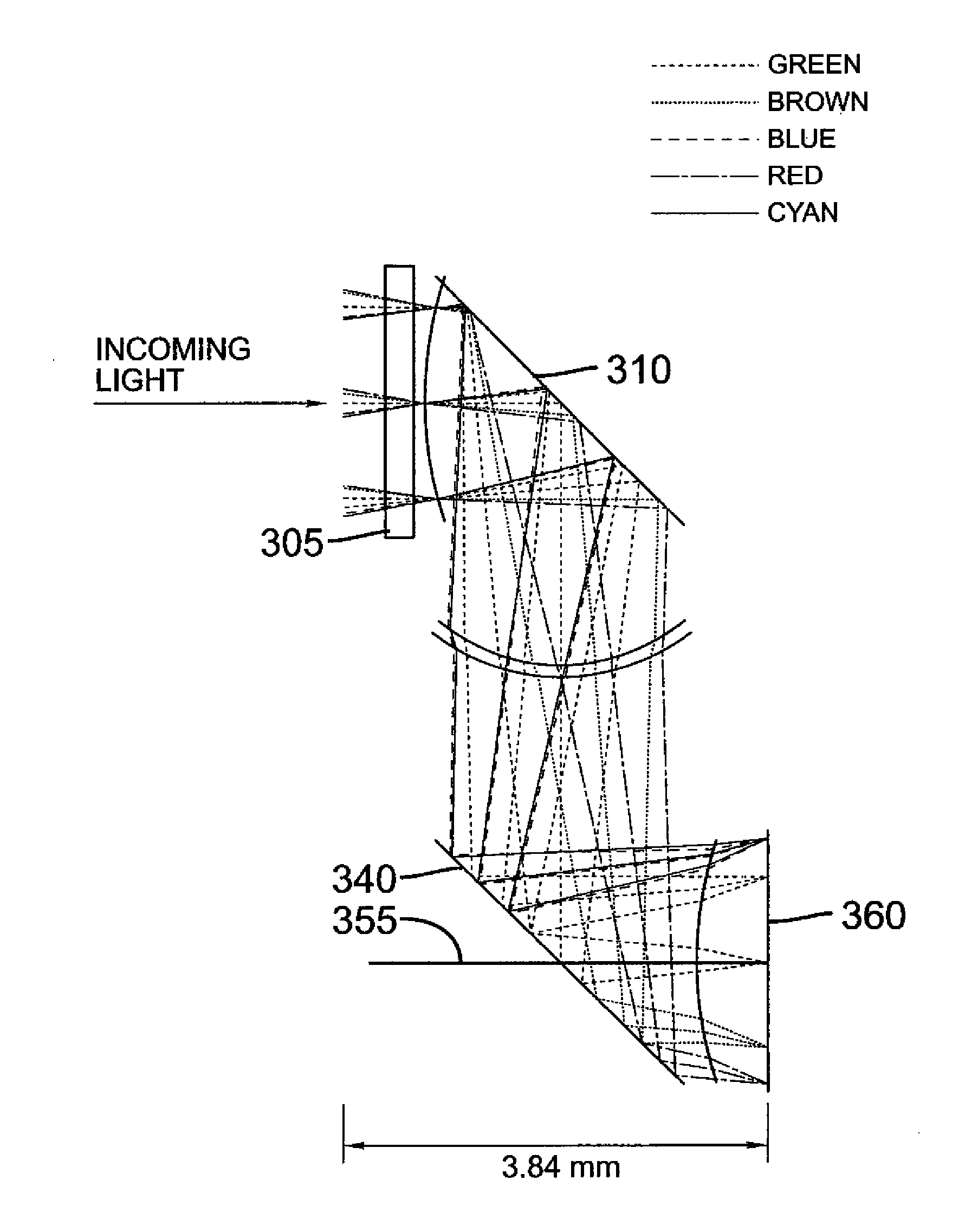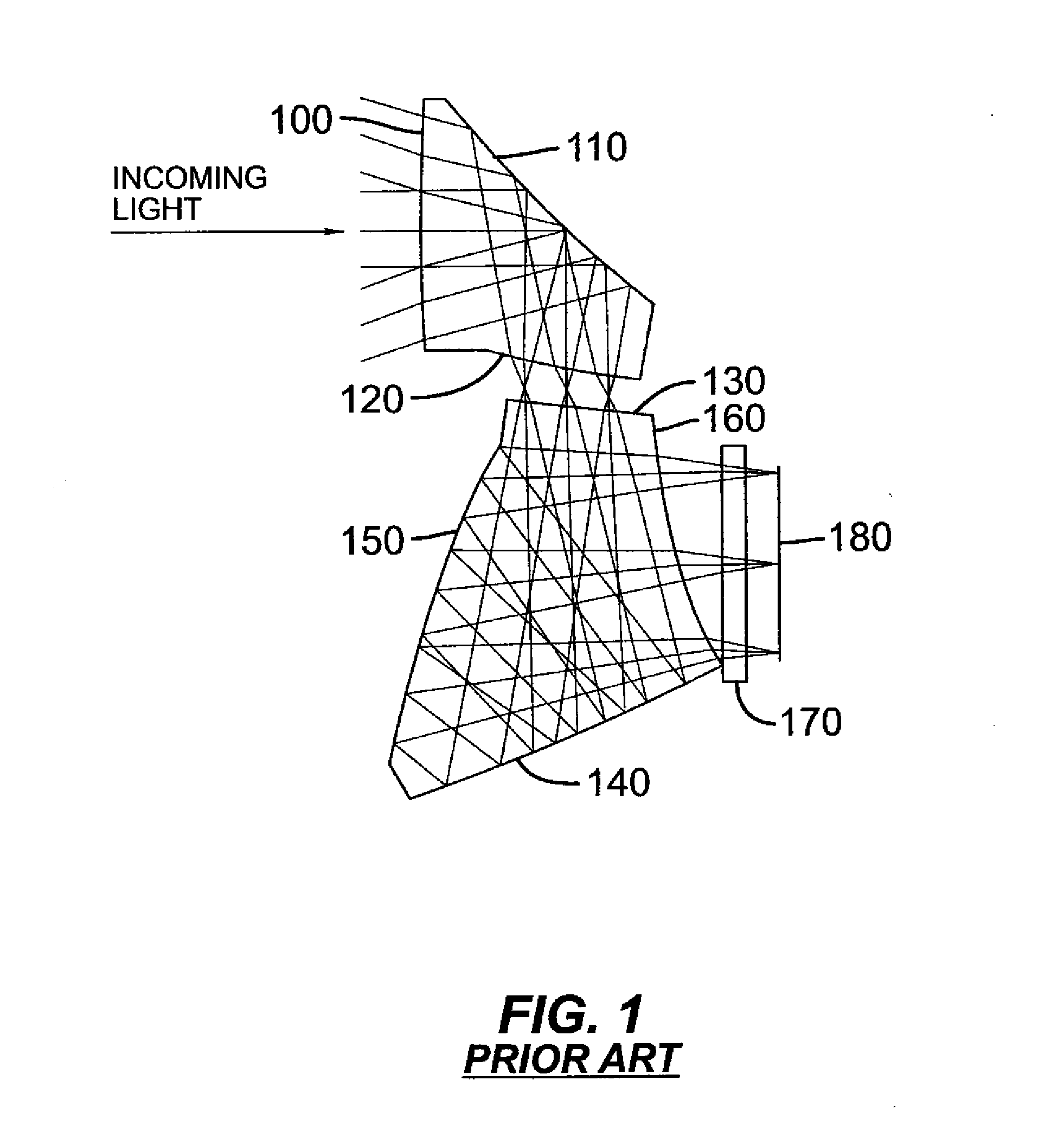Compact folded thin lens
a thin lens, compact technology, applied in the field of compact thin lens, can solve the problems of over 7 mm in thickness of the folded zoom lens assembly of takeuchi, relatively high cost, and relatively thick zoom lens assembly described by takeuchi, and achieve the effects of low cost, good optical performance and low cos
- Summary
- Abstract
- Description
- Claims
- Application Information
AI Technical Summary
Benefits of technology
Problems solved by technology
Method used
Image
Examples
example 1
[0041]Ray trace schematics for a lens with moderate angle field of view designed as an example of the invention is shown in a Z-shaped layout in FIG. 3 and a U-shaped layout in FIG. 4. The optical performance and the optical surfaces are the same for both the Z-shaped layout and the U-shaped layout. A description of the lens design including surface curvatures, lateral distances, aperture sizes and materials is given in Table 2 below. The lens is designed for an f# of 3.2, a pixel size of 0.002 mm and a sensor with two mega pixels. The modulation transfer function chart is shown in FIG. 6. The difference between the Z-shaped layout and the U-shaped layout versions of the lens are in the thickness dimension of the lens assembly, as can be seen in Table 1 and in FIGS. 3 and 4, the Z-shaped layout lens is 3.84 mm thick while the U-shaped layout lens is only 3.28 mm thick. For clarification, a cross sectional schematic of the U-shaped layout lens assembly with elements 510 and 520 along...
example 2
[0042]Ray trace schematics for a lens with a wider angle field of view designed as an example of the invention is shown in a Z-shaped layout in FIG. 7 and a U-shaped layout in FIG. 8. As in the lenses in Example 1, the optical performance and the optical surfaces are the same for both the Z-shaped layout and the U-shaped layout. A description of the lens design including surface curvatures, lateral distances, aperture sizes and materials is given in Table 3 below. The lens is designed for an f# of 3.2, a pixel size of 0.002 mm and a sensor with two mega pixels. The modulation transfer function chart is shown in FIG. 10. The difference between the Z-shaped layout and the U-shaped layout versions of the lens are in the thickness dimension of the lens assembly, as can be seen in Table 1 and in FIGS. 7 and 8, the Z-shaped layout lens is 3.15 mm thick while the U-shaped layout lens is only 2.56 mm thick. For clarification, a cross sectional schematic of the U-shaped layout lens assembly ...
example 3
[0043]Lenses with a telephoto angle field of view lens and a larger image sensor were designed as yet a further example of the invention. Ray trace schematics for a telephoto lens designed as an example of the invention are shown in a Z-shaped layout in FIG. 11 and a U-shaped layout in FIG. 12. As in the lenses in Examples 1 and 2, the optical performance and the optical surfaces are the same for both the Z-shaped layout and the U-shaped layout. A description of the lens design including surface curvatures, lateral distances, aperture sizes and materials is given in Table 4 below. In this case, the lens is designed for an f# of 3.2, a pixel size of 0.003 mm and a sensor with two mega pixels. The modulation transfer function chart is shown in FIG. 14. The difference between the Z-shaped layout and the U-shaped layout versions of the lens are in the thickness dimension of the lens assembly, as can be seen in Table 1 and in FIGS. 11 and 12, the Z-shaped layout lens is 6.34 mm thick whi...
PUM
 Login to View More
Login to View More Abstract
Description
Claims
Application Information
 Login to View More
Login to View More - R&D
- Intellectual Property
- Life Sciences
- Materials
- Tech Scout
- Unparalleled Data Quality
- Higher Quality Content
- 60% Fewer Hallucinations
Browse by: Latest US Patents, China's latest patents, Technical Efficacy Thesaurus, Application Domain, Technology Topic, Popular Technical Reports.
© 2025 PatSnap. All rights reserved.Legal|Privacy policy|Modern Slavery Act Transparency Statement|Sitemap|About US| Contact US: help@patsnap.com



